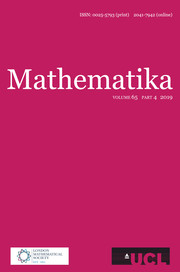Crossref Citations
This article has been cited by the following publications. This list is generated based on data provided by
Crossref.
Halton, J. H.
and
Zaremba, S. K.
1969.
The extreme and L2 discrepancies of some plane sets.
Monatshefte f�r Mathematik,
Vol. 73,
Issue. 4,
p.
316.
Halton, John H.
1970.
A Retrospective and Prospective Survey of the Monte Carlo Method.
SIAM Review,
Vol. 12,
Issue. 1,
p.
1.
Roth, K. F.
1976.
On irregularities of distribution, II.
Communications on Pure and Applied Mathematics,
Vol. 29,
Issue. 6,
p.
749.
Niederreiter, Harald
1978.
Quasi-Monte Carlo methods and pseudo-random numbers.
Bulletin of the American Mathematical Society,
Vol. 84,
Issue. 6,
p.
957.
Chen, W. W. L.
1980.
On irregularities of distribution.
Mathematika,
Vol. 27,
Issue. 2,
p.
153.
Guy, Richard K.
1981.
Unsolved Problems in Number Theory.
p.
132.
Sós, V. T.
1983.
Studies in Pure Mathematics.
p.
685.
Beck, J.
and
Chen, W. W. L.
1986.
Note on irregularities of distribution.
Mathematika,
Vol. 33,
Issue. 1,
p.
148.
Proinov, Petko D.
1988.
Symmetrization of the van der Corput generalized sequences.
Proceedings of the Japan Academy, Series A, Mathematical Sciences,
Vol. 64,
Issue. 5,
Guy, Richard K.
1994.
Unsolved Problems in Number Theory.
Vol. 1,
Issue. ,
p.
240.
Liang, R.
Woo, T. C.
and
Hsieh, C-C.
1998.
Accuracy and Time in Surface Measurement, Part 1: Mathematical Foundations.
Journal of Manufacturing Science and Engineering,
Vol. 120,
Issue. 1,
p.
141.
Chazelle, Bernard
2000.
FST TCS 2000: Foundations of Software Technology and Theoretical Computer Science.
Vol. 1974,
Issue. ,
p.
46.
Xiao, Yi-Jun
2000.
Monte-Carlo and Quasi-Monte Carlo Methods 1998.
p.
459.
Larcher, G.
and
Pillichshammer, F.
2002.
On the L2-Discrepancy of the Sobol–Hammersley Net in Dimension 3.
Journal of Complexity,
Vol. 18,
Issue. 2,
p.
415.
Chen, W. W. L.
and
Skriganov, M.M.
2002.
Explicit constructions in the classical mean squares problem in irregularities of point distribution.
Journal für die reine und angewandte Mathematik (Crelles Journal),
Vol. 2002,
Issue. 545,
Chen, W. W. L.
and
Skriganov, M. M.
2003.
Davenport's Theorem in the Theory of Irregularities of Point Distribution.
Journal of Mathematical Sciences,
Vol. 115,
Issue. 1,
p.
2076.
Temlyakov, V.N.
2003.
Cubature formulas, discrepancy, and nonlinear approximation.
Journal of Complexity,
Vol. 19,
Issue. 3,
p.
352.
Chen, W. W. L.
2004.
Fourier Analysis and Convexity.
p.
59.
Guy, Richard K.
2004.
Unsolved Problems in Number Theory.
Vol. 1,
Issue. ,
p.
365.
Travaglini, Giancarlo
2004.
Fourier Analysis and Convexity.
p.
245.


